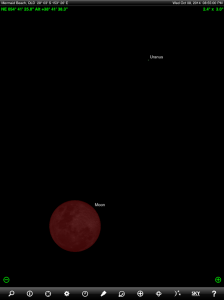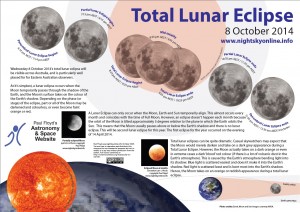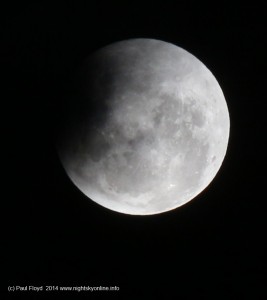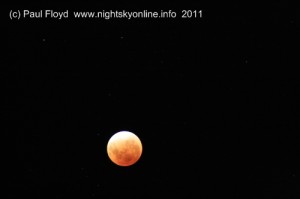(Posted 1 October 2014) I love celestial coincidences. In fact the only thing better than having two celestial ‘events’ occurring on the same night is having the two events happening near each other. This is happening next Wednesday (8 October 2014) when both a total lunar eclipse will occur at the same time the planet Uranus reaches opposition.

Wednesday’s Total Lunar Eclipse
Wednesday 8 October 2014’s total lunar eclipse will be visible across Australia, and is particularly well placed for for Eastern Australian observers.
| Total Lunar Eclipse Wednesday 8 October 2014 | Universal Time | Australian Eastern Standard Time | Australian Eastern Daylight Time |
| Penumbral eclipse begins | 08:14.1 UT | 6:14 pm AEST | 7:14 pm AEDT |
| Partial eclipse begins | 09:14.5 UT | 7:15 pm AEST | 8:15 pm AEDT |
| Total eclipse begins | 10:24.6 UT | 8:25 pm AEST | 9:25 pm AEDT |
| Greatest eclipse | 10:54.6 UT | 8:55 pm AEST | 9:55 pm AEDT |
| Total eclipse ends | 11:24.5 UT | 9:25 pm AEST | 10:25 pm AEDT |
| Partial eclipse ends | 12:34.7 UT | 10:35 pm AEST | 11:35 pm AEDT |
| Penumbral eclipse ends | 13:35.2 UT | 11:35 pm AEST | 12:35 pm AEDT |
At it’s simplest, a lunar eclipse occurs when the Moon temporarily passes through the shadow of the Earth, and the Moon’s surface takes on the colour of the Earth’s shadow. Depending on the phase (or stage) of the eclipse, part or all of the Moon may be darkened and colourless, or even become faint orange or red.

Download the PDF version of the fact sheet by clicking this link: 8 _October_2014_Total_Lunar_Eclipse_information_sheet (opens in new page).
A Lunar Eclipse can only occur when the Moon, Earth and Sun temporarily align. This almost occurs every month and coincides with the time of Full Moon. However, an eclipse doesn’t happen each month because the orbit of the Moon is tilted approximately 5 degrees relative to the plane in which the Earth orbits the Sun. This means that the Moon usually passes above or below the Earth’s shadow and there is no lunar eclipse. This will be second lunar eclipse for this year. The first eclipse for the year occurred on the evening of 14 April 2014.

Total lunar eclipses can be quite dramatic. Casual skywatchers may expect that the Moon would merely darken and take on a dark grey appearance during a Total Lunar Eclipse. However, the Moon actually takes on a dark orange or even in extreme cases a dark ‘blood’ red colour (if there is a lot of volcanic dust in the Earth’s atmosphere). This is caused by the Earth’s atmosphere bending light into its shadow. Blue light is scattered easiest and doesn’t make it into the Earth’s shadow. Red light is scattered least and is bent most into the Earth’s shadow. Hence, the Moon takes on an orange or reddish appearance during a total lunar eclipse.

Want to know when the next lunar or solar eclipse will occur? A good starting point is NASA’s eclipse website.
Uranus at opposition
By coincidence, the planet Uranus reaches opposition on the same night as Wednesday’s total lunar eclipse. This mysterious sounding term is a name given by astronomers to the time when a planet (as seen from Earth) rises as the Sun sets and sets as the Sun rises the following morning. For a ‘superior planet‘, this is effectively also the time of closest approach to the Earth for the year. Sadly even though Uranus is such a large planet (50 Earths by volume), its great distance from Earth means that through even a large telescope, it only appears as a very tiny disc.
The good news for those wanting to tick Uranus of their ‘seen it’ list is that Uranus is astronomically bright at magnitude +5.7. This puts it within the light grasp of a reasonable pair of binoculars. So, if you haven’t seen Uranus, wait till the light of the Moon is dimmed during the total lunar eclipse and then point your binoculars at the location shown on the finder chart (see top of page). There is no other star in that part of the sky that you can mistake Uranus for. Depending on your eyesight and sky conditions, you may also be able to detect a very faint blue colour.
Good luck and clear skies.